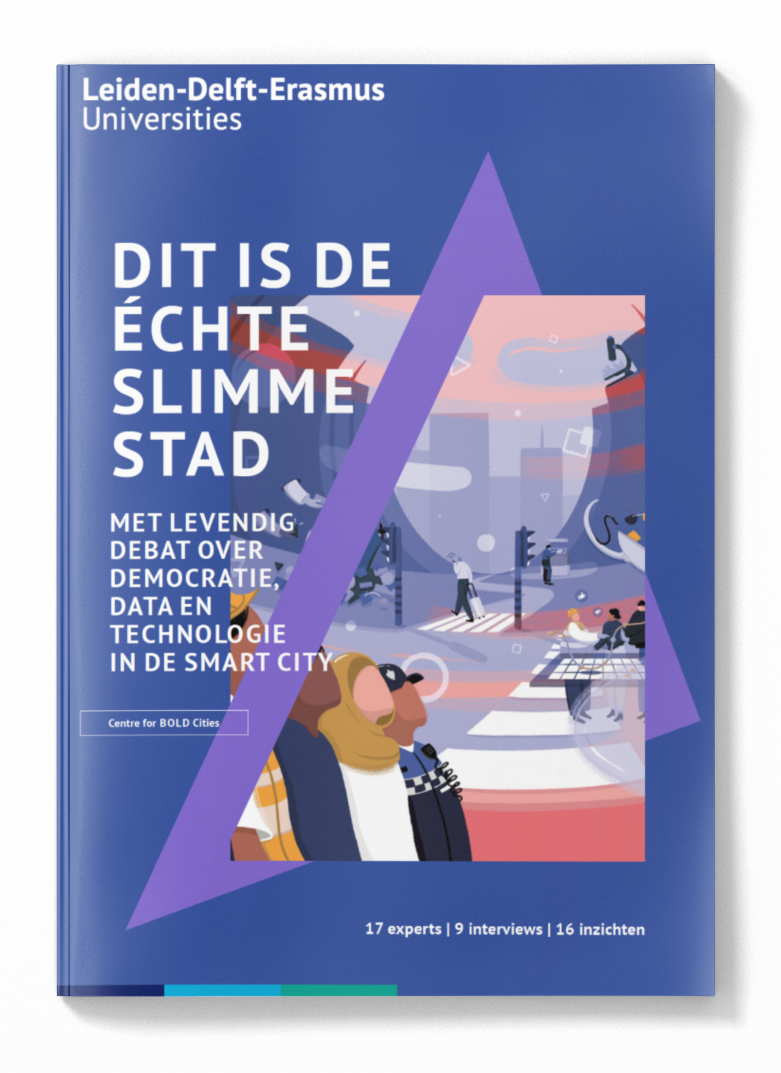Lampposts that detect passersby, a 5G mobile network: quite often, residents are not at all keen on technological innovation in outdoor spaces. While they are there for them, right? According to 5G critic Marnix Lamers and smart city researcher Vivien Butot, policymakers should not present technology as inevitable, but facilitate an open debate. By Jeroen van Raalte
A rare example of successful civil resistance
 It seemed such a good idea to the municipality of Utrechtse Heuvelrug. Lampposts equipped with Wi-Fi, sound sensors and 5G, the fifth-generation mobile telecommunication. However, when five years ago a group of residents got wind of the plan, they took immediate action. The collective, called ‘Radiate, We'd Rather Do It Ourselves’, had serious concerns about possible health damage caused by 5G radiation and about the privacy of citizens. ‘We then wrote a well-reasoned letter to the municipal council’, says involved resident Marnix Lamers.
It seemed such a good idea to the municipality of Utrechtse Heuvelrug. Lampposts equipped with Wi-Fi, sound sensors and 5G, the fifth-generation mobile telecommunication. However, when five years ago a group of residents got wind of the plan, they took immediate action. The collective, called ‘Radiate, We'd Rather Do It Ourselves’, had serious concerns about possible health damage caused by 5G radiation and about the privacy of citizens. ‘We then wrote a well-reasoned letter to the municipal council’, says involved resident Marnix Lamers.
Their account was heard. The group spoke with council members, launched a petition and was allowed to organise a council information session. 'The city council's registrar really thought our story added to the debate. One alderman even asked our advice for his note on lampposts.' The city council was persuaded. The lampposts did not materialise and, for now, there is no 5G network in Utrechtse Heuvelrug. It is a nice but also rare example of civil resistance making its mark on the decision-making process of a smart city project.
City officials present technology as inevitable

As happens with many technological innovations, city officials present the 5G network as something inevitable, says smart city researcher Vivien Butot. ‘In that view, what you think exactly about a technology doesn’t matter much. But citizens take a different position. They feel powerless because the government keeps presenting them with one fait accompli after another.’ ‘You can’t stop it anyway’, Lamers often hears. ‘Then I think: well, that just kind of depends.’
Butot studied the dynamics of the public debate about 5G. While the debate initially still focused on the usefulness and necessity of the technology, that discussion soon vanished into the background. ‘As the controversy grew and transmitter masts were set on fire, the focus of the debate shifted toward the health risks. According to the government, it is scientifically justified and that was the end of it. The desirability of 5G was no longer discussed'. While there are plenty of comments to be made about this 'inevitable' innovation. 'What problem will 5G solve? And what are the implications for people? Those questions are barely discussed.’

People are addressed as consumers who make use of a smart city product, not as an interest group.'
We do have consultations about a bike path, then why not about scan cars?
When there is to be a bike path, the Cyclists' Union will be heard. The residents' association gets to have its say on a new neighbourhood approach. But which citizens does the government consult with regard to a smart city application? 'When it comes to technology in outdoor spaces, there’s much less of a balancing of interests,' says Butot. 'People are addressed as consumers who make use of a smart city product, not as an interest group.' That the smart city rarely encounters organised protest does not mean that there is no resistance. On the contrary. 'There’s a lot of implicit resistance to new technologies, I notice in conversations. But often, people don't know how to channel their dissatisfaction.'
 As a result, the government can get the misconception that people think it is fine. As an example, Butot cites the scan cars that issue parking fines while driving around in his hometown. The camera images can also be used to spot dumped waste, the municipality figured out. 'Privacy-wise it was all right, but I was still sceptical. Because I know that many people in my neighbourhood are opposed to the scan cars. When the municipality then invents new applications, it forgets that the technology itself is already controversial. Just because there’s a consensus within the city administration on an application’s desirability, doesn’t mean that the population feels the same way.'
As a result, the government can get the misconception that people think it is fine. As an example, Butot cites the scan cars that issue parking fines while driving around in his hometown. The camera images can also be used to spot dumped waste, the municipality figured out. 'Privacy-wise it was all right, but I was still sceptical. Because I know that many people in my neighbourhood are opposed to the scan cars. When the municipality then invents new applications, it forgets that the technology itself is already controversial. Just because there’s a consensus within the city administration on an application’s desirability, doesn’t mean that the population feels the same way.'
Many a smart city application is a solution in search of a problem. The means then quickly becomes more important than the end, also in this case study. 'The problems with public space maintenance turned out to have an administrative cause. The municipality has outsourced management to all kinds of different companies. Scan cars are not the solution to this issue.'
Civic participation? No, government participation.’
Involve citizens both early and later on
At the moment, participation in smart city projects is very one-sided, Butot observes. ‘Citizens are involved in the decision-making process only late, when the technological solution has already been chosen. That feeds citizens' sense of powerlessness. We argue for contestability: for citizens to be involved in a debate on necessity and implementation from the start, and to be able to voice their dissatisfaction even after implementation.' By failing to do this, the government creates its own opposition: 'If Marnix's group hadn’t been heard, eventually they might’ve become a hard-line opposition group.'
Lamers affirms this. ‘Do you as a citizen really want to cooperate with a government that only asks for some feedback on a project that’s already been settled? Or do you want to participate at a more fundamental level, by joining the thought process about problems and solutions?’ He prefers to speak of ‘government participation’. ‘We’ve grown used to a juggernaut of a government to which we’ve outsourced our policy decisions. That’s increasingly being called into question. People are reclaiming their right to have their say.’ According to Lamers, this requires a different attitude from civil servants. ‘They shouldn’t hide behind an anonymous government apparatus. If a policy conflicts with the interests of citizens, they should step up to the mark.’
We didn’t want to be opposite but side by side with the city council.’
Resisting successfully, this is how
That the group of 5G-critical residents was successful in Utrechtse Heuvelrug, Lamers attributes to their basic attitude. 'We didn’t want to be opposite but side by side with the city council. Critical, but not going in with an outstretched leg. We explicitly called ourselves a dialogue group. That constructive attitude was appreciated. We reminded the city council of their administrative autonomy, that they were in danger of losing the reins. This made the council members scratch their heads for a moment.’
The open attitude of the municipality also contributed to a satisfying process. It recognised the critical residents as an interest group, facilitated their input and ensured that their concerns were taken into account. To Lamers’ satisfaction, the council eventually put a stop to the gadget-laden lampposts. Would he also have appreciated the decision-making process had the council made a different choice? ‘If they’d made a deliberate choice for those lampposts anyway, we would’ve been disappointed, but we would’ve felt heard.’
Vivien Butot is a PhD candidate at Erasmus University Rotterdam, where he studies how citizens react to the idea of the smart city. He studied the public dynamics surrounding 5G, among other things.
Marnix Lamers was involved in the local dialogue group Radiation Conscious Utrechtse Heuvelrug - ‘Radiate, We'd Rather Do It Ourselves’, which succeeded in convincing the municipal council to put a stop to 5G lampposts.

 White Paper about Smart Cities
White Paper about Smart Cities